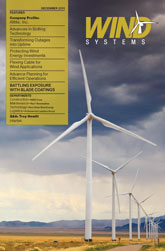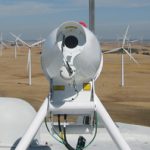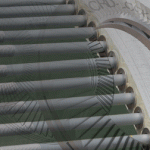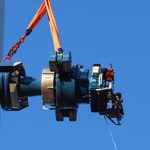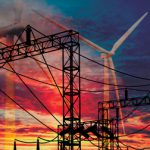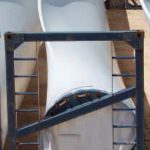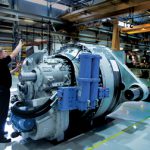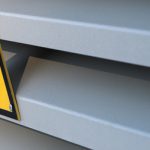Shortly before receiving my doctorate in wind science and engineering from Texas Tech University I began working for an electrical engineering firm, taking on the responsibility of wind energy development. In the last few months I have listened to and discussed comments about wind energy from various engineers in their respective departments. All seemed to be on the same topic; that wind developers wait until the last minute to do several things. Wind developers seem to take great care in the turbines they select and then rush the electrical design for the transmission, substation, and collection systems. This rush causes less than optimal economic design in order to meet project deadlines and makes for a less-efficient operating wind farm. Money spent up front is not lost, but affects the end product considerably. Here is what I have learned in the last few months at SGS Engineering.
After a wind developer has wind data and leased area, the actual development process begins. At this time early planning with an electrical engineering firm can be quite advantageous to the profitability of the wind farm. Not only can the engineering firm help with the interconnect agreement and making early decisions about metering, but their expertise can be used to the fullest in the complete design process. Because of decisions made without the aid of an electrical engineering company, several currently operating wind farms are now contacting them to fix mistakes made previously at substantial labor cost and downtime as conductors and equipment are replaced. An under-designed electrical collection (EC) system can cost a wind developer significantly in EC losses, reducing revenue over its entire life.
For new wind farms, every dollar saved during the early stages of development helps the project get off the ground. In the current economic state, power purchase agreements (PPAs) are difficult to obtain at a high enough price for viability, and again, proper review and evaluation of the system requirements in the early stages can be crucial to a successful long-term project. Figure 1
Early decision making areas may include some of the following: the SCADA system (software and compatibility with the equipment), electrical collection system (overhead vs. underground), cost of losses, bid documents, substations (expansion and redundancy), and transmission. By contacting an electrical engineering company in advance of purchasing turbines, the design costs can be controlled and efficiencies improved as all aspects of the wind farm are considered according to terrain, local politics, costs, taxes, efficiency, and turbine specifications. The largest area of savings is the electrical collection system, as it will benefit the wind farm for 20 years or more.
Electrical Collection System Design
Oftentimes a meteorologist places turbines for a project according to the local wind resource. Dwellings, roads, setbacks, and geographic features are also taken into account as the turbines are micro-sited. However, this frequently leads to a disjointed layout for electrical collection system leading to increased costs and higher losses. I have witnessed where a wind developer has come with a desired layout and was adamant about following it. After designing the EC to the layout the cost of the collection system became prohibitive, as it had to reach a hodgepodge of turbines placed at irregular intervals and remote locations due to the land-lease agreements.
When someone with wind energy understanding and electrical engineering know-how is given the freedom to micro-site the turbines, as is the case at SGS Engineering, the EC can be designed appropriately. With the ability to move one or two turbines to more conducive locations, hundreds of thousands of dollars may be saved. This can quickly add to enormous savings for a large, complete wind farm. By allowing knowledgeable engineers from a multidiscipline engineering firm to place the turbines, the EC system can be optimized, as well as the number and length of access roads needed for transportation and construction can be reduced. This, too, is another source of significant savings.
When designing the electrical collection, high resolution images can be easily imported into the engineering software enabling an engineer to maintain proper turbine spacing, setback distances from roads and homes, and avoiding terrain features that either affects wind flow or the degradation of buried EC conductors.
To better optimize the EC system, an electrical engineering economic model is used for determining conductor type and sizing. The model is built by taking into account the interest on the wind farm’s loan, local tax rates, depreciation, line-load factors, individual line-loss factors, and the estimated PPA. From this model the most economic, long-term conductor size can be easily determined based on the individual distances between turbines throughout the EC system. Built around these accurately supplied values it may be more economical to use a 4/0 conductor over 1/0 due to the value of the produced energy and the losses on that line over the life of the wind farm. For example, a 100-turbine wind farm with improperly sized conductors is experiencing 4 percent EC losses; four of the turbines are essentially used to offset the losses, and therefore produce no revenue. Analysis may direct the selection of conductors that would reduce losses to less than ½ percent.
Keeping conductor size changes to a minimum allows for ease in ordering and facilitates cheaper per-unit costs. Instead of ordering two miles each of 1/0, 4/0, 500, and 1000 MCM underground conductors, it may be more cost effective due to losses to order four miles of 4/0 and four miles of 1000 MCM conductors. It also may be more economical to place overhead lines between two rows of turbines than to have two or more underground circuits. This allows for more energy to enter the EC substation on fewer circuits, again, reducing costs. “Economic sizing of conductors allows more electrical product to be sold and greater revenue received,” according to SGS planning department head Mike Smith. Being able to place the EC substation in the most advantageous location is another skill of an electrical engineer. By moving a substation’s location within a wind farm, losses can be minimized with the reduction in lengths of underground or overhead conductors, maximizing output and improving revenue.
Substation Design
Additional savings can be found when proper planning precedes the designing of substations. Not only is substation siting paramount to power delivery, but rushed work provides little time for review and increases opportunities for poor design. Substation equipment needs to be competitively bid. Availability isn’t necessarily better. “Availability and fast turnaround seems to be the norm in wind farm construction,” says Monte Wolgamott, partner and project manager of substation design at SGS.
“We have seen wind developers save a few thousand dollars per pad-mount transformer for the turbines and then lose $1 million a year in electrical losses by accepting the low bid versus a ‘loss evaluated’ cost review of the transformers.”Typical response time for transformer, circuit breaker, and circuit switcher bids is 21 days, with a delivery time of three to five months. Allowing the engineer to include important loss evaluation data into the acceptance of submitted bids is essential for cost savings. The more detailed the specification, the less room for uncertainty, and the better application of the product. If equipment is poorly specified, uncertainty with the vendor could cause them to overestimate the cost or affect the quality of the supplied product.
Since a wind farm will be connecting with a utility, it is best to find a firm that has the unique experience of working with regional utility providers. Redundancy in a wind energy substation provides reliability to the utility and improves production opportunities. This redundancy is used to provide continued service even during a single equipment failure anywhere within the system. The engineer and client will determine the necessity level of redundancy based on the understanding of how the system needs to be operated: single verses double substation locations, single verses two power transformers, and breaker bypass versus a transfer bus arrangement. These are a few examples of redundancy or first contingency planning. It is also good planning on the collector design side to install circuits on different sides of the road or along different routes. This is an attempt to avoid any single event preventing the operation of the entire system. Each is designed to interrupt only the affected portion(s) of the system while maintaining output and reliability from the balance of the wind power facility.
Another cost savings area is in decisions that are made based on a limited amount of data. Oftentimes time-warranted judgments concerning communications and monitoring SCADA equipment are deferred until the end of the project. When these decisions are finally made, changes may be required in the drawings or the equipment. Due to rework, modification, or rebuilding of some components of the substation, a hastily prepared plan will expand the cost of the substation design, easily reaching double the engineering cost of a typically designed substation. The later in the process these changes are made, the more costly they may become.
Prior planning for the future is also important in substation design. Recently, a wind farm wanted to add a second phase to the project. Before the original project was constructed a second phase was considered, but it was never mentioned to the engineer. The 150MW substation was constructed at $3.1 million. When the 100MW second phase was brought to our attention, the developer wanted the new substation to be a part of the previously built one. This new substation cost $2.9 million due to the numerous electrical changes that had to take place in combining the two substations. Had the second phase possibility been mentioned earlier, the original substation would have been designed and pre-built with locations in place for future transformers for the expanding wind farm. If the original substation had incorporated the future expansion and constructed with all relevant equipment in place except the future transformers, the complete substation would have cost $4 million—a savings of $2 million simply from prior planning.
Transmission
An often overlooked stage in the wind farm process is the transmission line engineering and development. Contacting an electrical engineering design firm early in the development process can eliminate a significant number of unknowns. For bid purposes, preliminary engineering can save a wind developer a substantial sum in anticipated costs by improving initial estimates, determining potential route alternatives, structure types, heights and quantities, conductor sizes, span lengths, and right-of-way widths. Without preliminary engineering, contractors are forced to include many contingencies in their bid that might otherwise be avoided. These contingencies add substantial costs to engineering, procurement, and construction (EPC) bid prices. Pre-engineering can reduce these contingency costs on EPC bids. “Preliminary engineering is critical for optimal construction costs in the bidding process,” says Donny Payne, partner of SGS and head of the transmission department.
If the pre-engineering is not performed, it may be determined late in the process that a larger overhead conductor size is needed. A larger conductor may mean stronger poles, which can cost the contractor in both time and money if the project is delayed.
Conclusion
In conclusion, while the multidisciplinary Ph.D. program taught me a plethora of information about wind energy, it was not until I began working that I learned how early engineering involvement in wind energy projects is so important. Substantial savings can be found in electrical collection costs from properly sized conductors and in a reduction of cumulative losses. Another significant amount can be saved in substation design due to competitive bidding on proper equipment as specified by the connecting utility. Allowing time for CAD drawings to be done properly will save time and therefore money when there are few to no mistakes and little in way of changes. Early preliminary engineering from a transmission standpoint allows for proper construction bidding by eliminating costly contingencies in the bid process. By reducing costs at each stage of the development, combined total savings can reach several million dollars for a large wind farm when working with qualified electrical engineering companies that have experience working with wind energy.
Wind developers need to be in contact with an engineering company that has a unique perspective on energy production from beginning to end. Money spent on one improvement can be returned several times the cost over the life of the wind project. The “best answer at the appropriate price” means working with consultants for one to two months before the submission of the interconnect request to the appropriate authority.



















